Facts about the Ceres dwarf planet
Ceres has been an object of interest in astronomy for over two hundred years. In that time, it has shifted in its classification several times, being demoted and promoted as several types of object. Let’s take a look at some interesting Ceres Facts before diving further in to this interesting dwarf in our solar system.
- Ceres was the first object to be considered an asteroid in the solar system, and does indeed exist within the asteroid belt. In early 1801, an Italian astronomer by the name of Giuseppe Piazzi discovered and named Ceres. He originally classified it as a planet, but it has since been reclassified as a dwarf planet.
- Ceres accounts for approximately one-third of the total mass of the entire asteroid belt. However, it cannot be classified as a planet since it does not “dominate its orbit” and shares it with thousands of asteroids.
- The unmanned spacecraft Dawn arrived at Ceres in early 2015. It was launched by NASA on 27th September 2007. This made Ceres the first dwarf planet that was visited by a spacecraft.
- Ceres was named for the Roman god of agriculture, Ceres (or Cerere in Italian) who is also known as Demeter in Greek mythology. The original name of Cerere Ferdinandea was changed after there were objections to Ferdinandea.
- Ceres was classified as a planet for half a century from 1801 until the 1850s when it was reclassified as an asteroid. In 2006, it was subsequently classified as a dwarf planet.
- The presence of water ice on Ceres has led to speculations that life may exist there. However, discussions about life on Ceres are not as active as those about Mars and Europa.
- Ceres is believed to have a rocky core with an icy inner mantle that is 100 km thick. Scientists have calculated that this ice mantle may contain as much as 200 million cubic km of water—that’s more fresh water than can be found on planet Earth!
- Ceres is generally regarded as too dim to be seen with the naked eye. Still, a viewer with exceptional eyesight under the right conditions might be able to see the dwarf planet.
- Ceres completes its orbit once every 4.6 Earth years. This dwarf planet makes a full rotation every nine hours and four minutes.
What Is a Dwarf Planet?
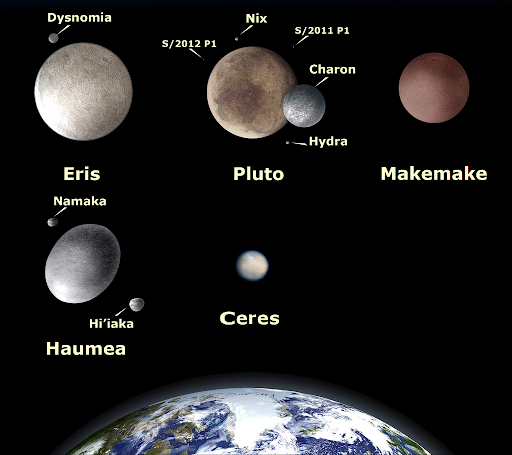
Dwarf planets share some similarities with the eight planets, but not everything. This is a different class of celestial bodies that are present in large numbers in the solar system. In terms of size, these objects are much smaller than the planets.
The International Astronomical Union (IAU) had set four requirements. For an object to be considered a dwarf planet, it must:
- Orbit the Sun
- Not be a moon orbiting another body
- Not be massive enough to clear its orbit from other objects
- Have enough mass to assume a nearly round shape
The five official dwarf planets recognized by the IAU are Ceres, Pluto, Eris, Makemake, and Haumea. Other possible dwarf planets are Sedna, Orcus, Quaoar, and Varuna. Thousands of dwarf planets are believed to be lying in the far regions beyond Neptune’s orbit, waiting to be discovered.
The Dwarf Planet Ceres
Ceres

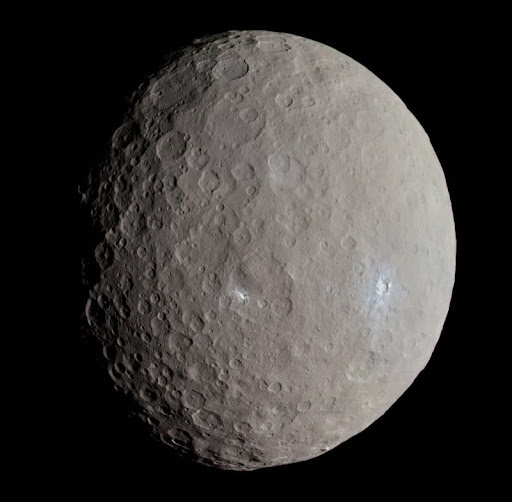
- MPC designation – (1) Ceres
- Discoverer – Giuseppe Piazzi
- Discovery Date – January 1, 1801
- Semi-major Axis – 2.8 AU
- Orbital Period – 4.61 Earth years
- Eccentricity – 0.08
- Inclination – 10.59° (to the ecliptic)
- Dimensions – 964.4 × 964.2 × 891.8 km
- Mean Radius – 476.2 km
- Rotation Period – 9 hours
- Surface Temperature – ≈110 to 235 K
- Apparent Magnitude – 6.64 to 9.34
Ceres is the closest dwarf planet to the Sun. It lies on the main asteroid belt, between the planets Mars and Jupiter. Its orbit, however, is closer to the red planet than that of Jupiter’s.
This dwarf planet was given the designation (1) Ceres by the Minor Planet Center (MPC). Discovered in 1801, this object was the first asteroid ever discovered. It was first thought of as a planet, then reclassified as an asteroid, until it became known as a dwarf planet.
Ceres has nearly three times the distance of the Earth to the Sun. With that distance, it takes roughly 22 minutes for sunlight to reach its surface. Its orbit is not elongated but is a bit tilted with an orbital inclination of 10.59°. It completes a journey around the Sun in about 4.6 years. With a rotation period of about 9 hours, Ceres has one of the shortest days in the solar system!
Ceres has a generally round shape with a mean radius of 476.2 km. It is the smallest of the five dwarf planets and the only one with no natural satellite. Also, it has no ring system.
Discovery Details

Astronomers in the past were curious about the gap between Mars and Jupiter. They thought that there must be a missing planet that lie in the area. Many experts in the field joined in the search for the said planet. One of them was the Italian astronomer Giuseppe Piazzi who was also a Catholic priest from Sicily.
Piazzi was originally looking for a star when he came across Ceres on the first day of January 1801. He made the discovery at the Palermo Astronomical Observatory.
Initially, he thought that the object was a comet. However, he had his doubts since the object moved differently than comets. Confirming his observations in the latter part of the year was quite a challenge because the apparent magnitude of the object has changed.
Ceres was recovered again with the help of German mathematician Carl Friedrich Gauss’s method of determining a celestial body’s orbit. It proved Piazzi’s earlier assertion that the said astronomical object was not a comet.
Behind the Name

Piazzi named his discovery Ceres Ferdinandea to pay homage to Sicily. It was inspired by Ceres, the Roman goddess of agriculture and grain, and King Ferdinand. The second part of the name, however, was dropped due to political reasons. We use the adjectival forms Cererian and Cererean for this name.

Minor planets were given symbols before but since there are more and more of them getting discovered, assigning these symbols would be inconvenient. With this, German astronomer Johann Franz Encke proposed the system of placing numbers before the names of these objects.
Since Ceres was discovered early on, it had an astronomical symbol which is a sickle. It was a classical symbol of the goddess of grain who it was named after.
How Did Ceres Form?
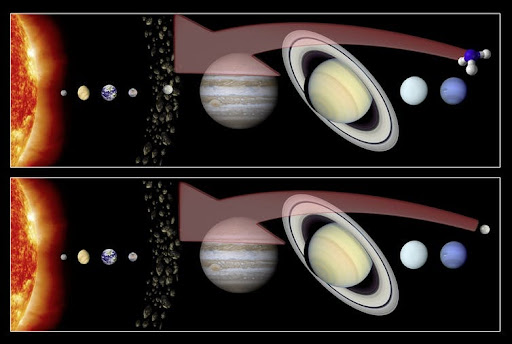
The origin of Ceres can be traced back to the birth of the planets. It is called a protoplanet or a planetary embryo. It originated in the same way as the planets but it did not fully develop as one.
Ceres may have formed in the outer solar system, in the area between Jupiter and Saturn, or even way farther in the Kuiper belt. The presence of ammonia salts in its Occator crater suggests this because ammonia is far more abundant there. Also, the ammoniated clays were not vaporized by the Sun since it is much farther. It was probably brought into its current position because of gravitational influences.
Another theory is that it may have formed on the asteroid belt, where it is now, and the materials from the outer solar system may have just migrated inwards. Still, these theories are yet to be confirmed.
Together with Ceres, other surviving protoplanets in the inner solar system are Pallas and Vesta.
What Makes Ceres Different From Other Dwarf Planets?
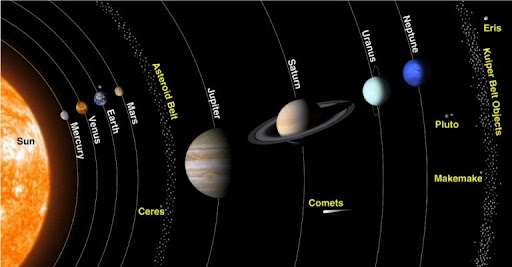
Ceres is different from other dwarf planets because of its location. While Pluto, Eris, Makemake, and Haumea are all in the Kuiper Belt, past the orbit of Neptune, Ceres is in the asteroid belt. This makes it the only dwarf planet located in the inner solar system.
Ceres is also unique because it contains a lot of water. It shares a lot of features with the terrestrial planets, Mercury, Venus, Earth, and Mars. This dwarf planet most likely has a solid core with water ice as its mantle.
Overall, it is thought that Ceres is more than 25% water—even more water than the Earth has. This characteristic makes it a probable place for life and habitability as we know it. Other than that, it also has interesting features such as bright spots (faculae), craters, and cryovolcano features.
Planet, Asteroid, or Dwarf Planet?
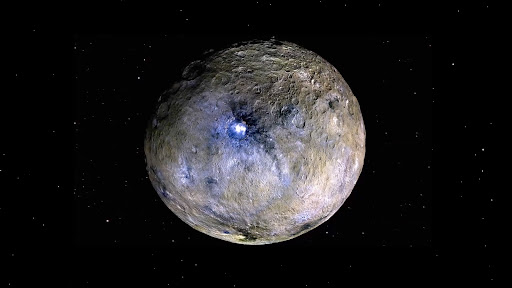
Ceres has been under different classifications ever since its discovery. Astronomer Johann Elert Bode, who published the much speculated Titius–Bode law, called it the “missing planet.” Its location seemed to fit the Titius–Bode law, though it is now thought to be just a coincidence.
Upon Piazzi’s discovery in 1801, Ceres was considered a planet. It was categorized so for a long time until the 1850s when similar objects like it were discovered. The term “asteroid” was coined for these objects as early as 1802. In 1863, it was widely accepted that Ceres was an asteroid and not a planet.
The classification of Ceres was once again challenged in 2006. On the 24th of August of that year, the then-planet Pluto was reclassified as a dwarf planet. The reason for this was that Pluto was not able to fulfill the third criteria for it to be considered a planet. This criterion states that a planet should have “cleared the neighborhood around its orbit.”
Pluto was not able to meet the criteria, and so was Ceres. Because of that, these two astronomical bodies are now categorized as dwarf planets together with Eris, Makemake, and Haumea.
Ceres Features and Characteristics
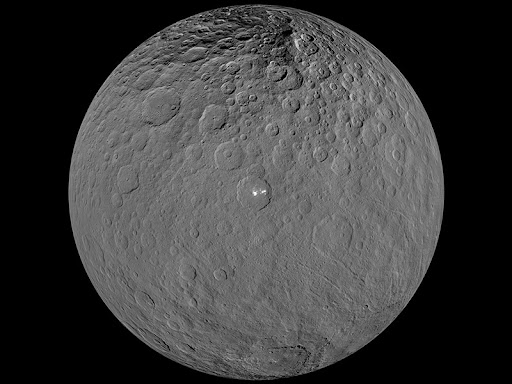
Ceres is geologically active. It has a differentiated structure, with distinct layers. Its mantle is made up of hydrated rock while the thick outer crust is a mixture of ice, salts, and hydrated minerals. Between these two is a layer of brine or liquid rich in salt.
On the surface, Ceres is covered in mostly small craters that are less than 300 km in diameter. This dwarf planet has an atmosphere but it is very thin. Scientists found that it contains water vapor which is most likely from ice volcanoes. It can also be a result of ice sublimation. So far, there is no indication that Ceres has a magnetosphere.
Ceres is the largest object in the asteroid belt but the smallest of the five dwarf planets known so far. This body emits vapor and is the closest cryovolcanic object to the Sun. It is about 950 km across, with the dimensions 964.4 × 964.2 × 891.8 km. It is 13 times smaller than Earth. Ceres is also 2.4 times smaller than the largest dwarf planet, Pluto.
Size of Ceres Compared With the Earth
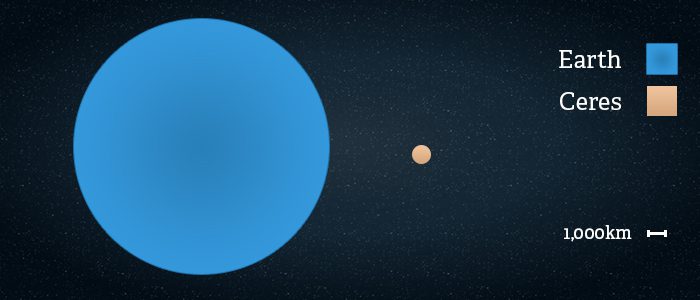
Side by side size comparison of the size of Ceres vs Earth
Ahuna Mons
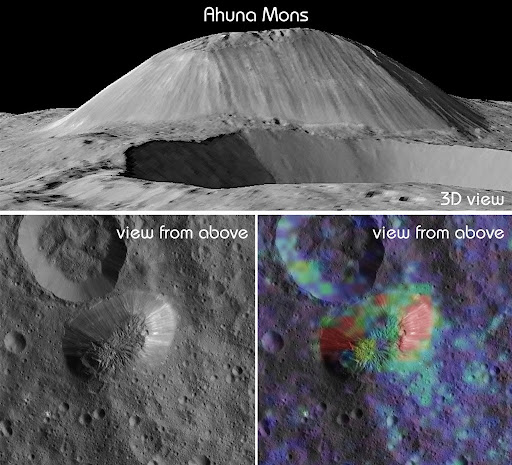
Ahuna Mons is the tallest mountain on Ceres. Its average height is estimated to be 4 km (2.5 mi). The base is around 20 km (12 mi) wide. It was discovered by the Dawn team in 2015.
Among the most striking features of this mountain are the bright streaks on its slopes. It is most likely a cryovolcanic dome and was formed by mud plumes from Ceres’s mantle.
Occator Crater
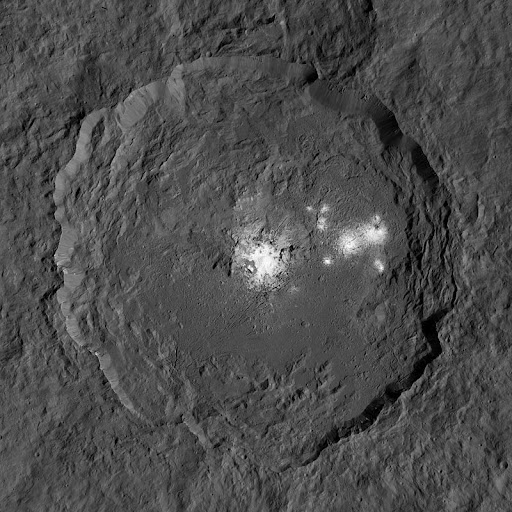
Occator crater is one of the impact craters found on the dwarf planet Ceres. It measures 92 km (57 mi) across and is about 3 km (1.9 mi) deep. This crater has a small dome called Cerealia Tholus. Aside from that, the Occator crater has prominent bright spots caused by brine.
Bright Spots (Faculae)
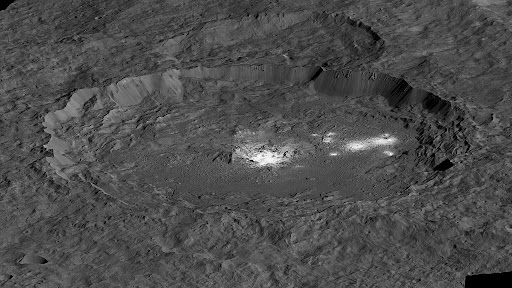
The bright spots on Ceres are called faculae (singular: facula). The Dawn spacecraft was able to observe hundreds of these features on the surface of Ceres. The brightest of these spots are in the Occator crater. They are called Cerealia Faculae and Vinalia Faculae.
Cerealia Faculae is the bright spot in the center that covers the central tholus. On its east is the other group of bright spots called Vinalia Faculae.
Did You Know?
Hygiea is another possible dwarf planet in the asteroid belt. Since it is only about 430 km (267 mi) across, it is likely the smallest dwarf planet known, snatching the place from Ceres. Still, that is something that is yet to be confirmed.
Can We Live on Ceres?
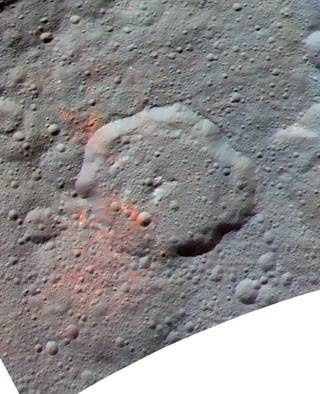
This enhanced color composite image, made with data from the framing camera aboard NASA’s Dawn spacecraft, shows the area around Ernutet Crater. The bright red portions appear redder with respect to the rest of Ceres.
Ceres is abundant in water, which is beneficial when it comes to life. It suggests that it might have developed primitive life in the past.
Evidence of organic material was found on Ceres’s Ernutet Crater by NASA’s Dawn spacecraft. This is a great discovery since organic molecules are important ingredients for life as we know it on Earth. Also, these organics seemed to have formed on the surface instead of being brought by impacts.
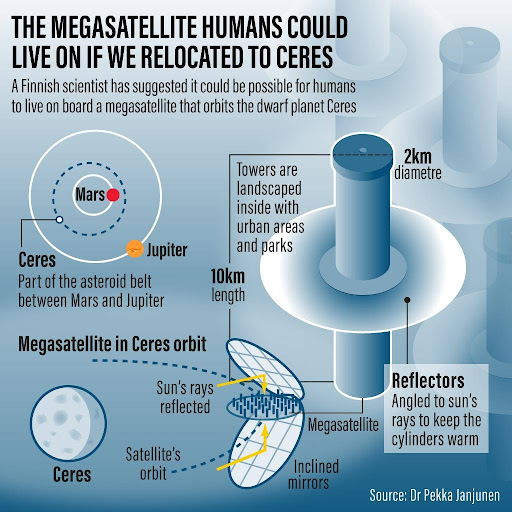
Another interesting take on the chances of habitability on Ceres was proposed by Finnish physicist, Dr. Pekka Janhunen. This vision for life around the dwarf planet involves a “megasatellite.”
But why Ceres?
Though Ceres is farther from us than the Moon and Mars, it has more resources needed to sustain the satellite such as oxygen, water, and nitrogen. Also, Ceres has low gravity just like Mars and the Moon. This problem is addressed by the gravity-producing “spin driers” of the huge satellite.
There are still so many questions regarding this vision of life on a “spinning tower” around the dwarf planet Ceres. It still has a long way to go but it gives us an idea of the possibilities of life outside our own planet.
Ceres Facts – Missions on Ceres
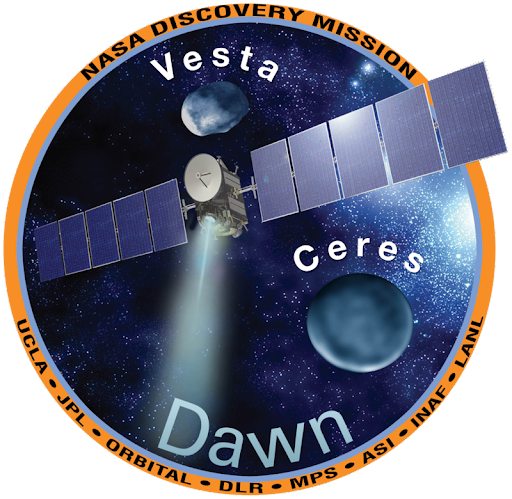
Before the Dawn mission, we already had some clues about Ceres thanks to Europe’s Herschel Space Observatory and NASA’s Hubble Space Telescope.
The Dawn mission was the first and most important mission on Ceres so far. It made history as the first spacecraft to visit a dwarf planet. It was also the first to successfully orbit two separate extraterrestrial bodies. A lot of Cererian features were discovered during the spacecraft’s stay in orbit.
Launched on September 27, 2007, Dawn first visited Vesta, the second-largest object in the asteroid belt. It entered Vesta’s orbit in 2011 and after completing the 14-month survey mission, it headed to Ceres.
Dawn left for Ceres in 2012 and entered the dwarf planet’s orbit in March 2015. This space probe retired in 2018 when it had exhausted its hydrazine.
Scientists think that a lander would be able to study the composition of Ceres better. The European Space Agency (ESA) and the China National Space Administration (CNSA) have plans for return-sample missions to Ceres. These are exciting news that we can hope to hear more about in the future!
More Interesting Ceres Facts
- Ceres has the same name origin as the word “cereal.” Both are named after the Roman goddess of grain and harvests.
- For a long time, Ceres was considered the largest asteroid in the main asteroid belt. This label now belongs to Vesta, the second-largest object in the area.
- Though Ceres is already classified as a planet, some people still consider it as an asteroid at the same time. This is largely because the Minor Planet Center (MPC) notes that dwarf planets can have dual designations.
- Due to its size and the fact that it was considered a planet before, many will think that Pluto was the first dwarf planet found. But if we look at the discovery dates, it was actually Ceres. While Pluto was discovered in 1930, Ceres was discovered way earlier in 1801!
- In our lifetime, the closest approach of Ceres to Earth is predicted to be in the year 2032. By that time, the dwarf planet is speculated to be as close as about 1.6 AU.
Sources:
https://solarsystem.nasa.gov/planets/dwarf-planets/cerespage=0&per_page=10&order=launch_date+desc%2Ctitle+asc&search=&tags=Ceres&category=33
https://en.wikipedia.org/wiki/Ceres_(dwarf_planet)
https://www.space.com/28740-dwarf-planet-ceres-strange-facts.html
https://www.nationalgeographic.com/science/article/151110-ceres-dawn-ammonia-outer-solar-system-nasa
https://en.wikipedia.org/wiki/Ahuna_Mons
https://en.wikipedia.org/wiki/Occator_(crater)
https://www.jpl.nasa.gov/infographics/what-is-a-dwarf-planet
https://www.nasa.gov/feature/jpl/dawn-discovers-evidence-for-organic-material-on-ceres
https://www.thenationalnews.com/uae/science/life-on-ceres-forget-the-moon-humans-could-move-to-a-ball-of-rock-in-an-asteroid-belt-1.1157322
(https://www.odysseymagazine.com/ceres-facts-for-kids/)
Image Source:
Dwarf planets: https://upload.wikimedia.org/wikipedia/commons/thumb/0/09/Dwarfplanets5.png/1024px-Dwarfplanets5.png
Ceres: https://upload.wikimedia.org/wikipedia/commons/thumb/7/76/Ceres_-_RC3_-_Haulani_Crater_%2822381131691%29_%28cropped%29.jpg/800px-Ceres_-_RC3_-_Haulani_Crater_%2822381131691%29_%28cropped%29.jpg
Ceres symbol: https://upload.wikimedia.org/wikipedia/commons/thumb/c/ca/Ceres_symbol.svg/800px-Ceres_symbol.svg.png
Giuseppe Piazzi: https://upload.wikimedia.org/wikipedia/commons/9/92/Giuseppe_Piazzi.jpg
Ceres goddess: https://upload.wikimedia.org/wikipedia/commons/thumb/e/e1/Ceres_-_Dominikus_Auliczek_um_1770-1.jpg/800px-Ceres_-_Dominikus_Auliczek_um_1770-1.jpg
Ceres formation: https://images.theconversation.com/files/105064/original/image-20151209-15567-14qwjcc.jpg?ixlib=rb-1.1.0&q=45&auto=format&w=754&h=507&fit=crop&dpr=1
The Solar system: https://www.st-blaise.oxon.sch.uk/wp-content/uploads/2019/09/the_planets-1024×533-768×400.jpg
Ceres with Occator crater at the center: https://solarsystem.nasa.gov/system/stellar_items/image_files/704_feature_1600x900_ceres.jpg
Ceres as seen from Dawn: https://solarsystem.nasa.gov/system/feature_items/images/141_PIA21906_800w.jpg
Ahuna Mons: https://upload.wikimedia.org/wikipedia/commons/thumb/4/4a/PIA21919-Ceres-DwarfPlanet-AhunaMons-20180314.jpg/800px-PIA21919-Ceres-DwarfPlanet-AhunaMons-20180314.jpg
Occator crater: https://upload.wikimedia.org/wikipedia/commons/thumb/f/f0/PIA20350_crop_-_Occator_from_LAMO.jpg/800px-PIA20350_crop_-_Occator_from_LAMO.jpg
Bright spots (Cerealia Faculae and Vinalia Faculae): https://upload.wikimedia.org/wikipedia/commons/thumb/4/4d/PIA21913-DwarfPlanetCeres-OccatorCrater-SimulatedPerspective-20171212.jpg/1024px-PIA21913-DwarfPlanetCeres-OccatorCrater-SimulatedPerspective-20171212.jpg
Ernuter Crater: https://www.nasa.gov/sites/default/files/styles/side_image/public/thumbnails/image/pia21419_main.jpg?itok=Ez-bB5Z7
Megasatellites by Dr. Pekka Janhunen: https://thenational-the-national-prod.cdn.arcpublishing.com/resizer/GJ0OAxoTYZ-RVjlQujMvTITe2F0=/1024×0/filters:format(jpg):quality(70)/cloudfront-eu-central-1.images.arcpublishing.com/thenational/6MQYWDLEQAYALL5NTPJKVZDG4A.jpg
Dawn mission: https://upload.wikimedia.org/wikipedia/commons/thumb/3/35/Dawn_logo.png/800px-Dawn_logo.png